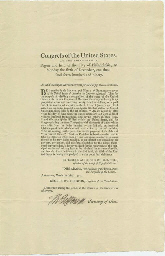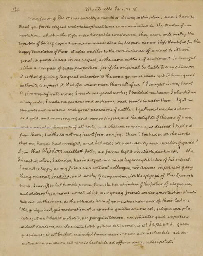JEFFERSON, Thomas (1743-1826), President . Partly printed document signed ("Th: Jefferson") as Secretary of State in Washington's first term: Resolved...that the President...cause an estimate to be laid before Congress... [Philadelphia: Childs & Swaine 1791]. Folio, 15 3/8 x 9½ in. Bold typographic heading "Congress of the United States," signed in type at bottom by Speaker Muhlenberg, Vice-President John Adams and President Washington. In extremely fresh, near-mint condition, with original deckle edges intact. Evans 23882; C.B. Bickford and H.E. Viet, Documentary History of the First Federal Congress , 6:2127-8. MEASURING THE NORTHWEST TERRITORY: CONGRESS REQUESTS A SURVEY OF THE LANDS "NOT CLAIMED BY THE INDIANS" In anticipation of vastly increased westward settlement, Congress enacted the Land Act of 1785 and the Northwest Ordinance in 1787, creating the Northwest Territory, stretching from the slope of the Alleghenies to the Mississippi and including present-day Ohio, Indiana, Michigan, Illinois, Wisconsin and parts of Minnesota. The Ordinance, largely drafted by Thomas Jefferson made specific provision for the government of the vast new territory, set up procedures for the distribution of lands and specified the process by which the territories could achieve statehood. A territorial government was established under General Arthur St. Clair in July 1788. The territorys' rich lands, once surveyed, were to be sold to settlers or granted to the many veterans of the Revolution, some of whom had still not been compensated for their services. In May 1790, from western lands ceded by North Carolina, Congress created another territory south of the Ohio River, to be similarly governed. But the native American tribes, especially the Miamis, Senecas and other tribes north of the Ohio River (as well as the Shawnees and Cherokees to the south), vigorously resisted encroachment on their lands, and their unrest was encouraged by British agents based along the disputed border with British Canada. The U.S. government insisted that "at various conferences subsequent to the Revolution, the Indians had, indeed, ceded most of the Territory northwest of the Ohio. However, there was the usual confusion as to whether the various Indian deputations had possessed official authority. The tribes repudiated the treaties..." (J.T. Flexner, George Washington and the New Nation , p.298). The broadside announces a joint resolution by the Senate and House calling upon President Washington to "cause an estimate to be laid before Congress at their next session, of the quantity and situation of the lands not claimed by the Indians, nor granted to, nor claimed by any citizen of the United States, within the territory ceded to the United States, by the state of North Carolina and within the territory of the United States north-west of the river Ohio." The worsening relations with the Native Americans in the Northwest culminated in the bloody victory of the Miami and Seneca tribes over U.S. troops commanded by General Arthur St. Clair, 3 November 1791. St. Clair's devastating defeat--in which some two-thirds of his army were casualties--shocked Washington and electrified Congress: "Nothing so ghastly, so humiliating...had been experienced...since that dreadful 9th of July, 1755, when Braddock's bewildered redcoats had been the target of unseen marksmen on the Monongahela" (D.S. Freeman, George Washington: Patriot and President , p.339). On November 10, 1791, in compliance with the present act, President Washington submitted a report on the Indian land-holdings in the Ohio Territory; then, two days later, he forwarded the grim accounts of St. Clair's humiliating defeat. Diplomacy was superceded by a strong military response and for the next several years the Ohio Valley were the scene of unremitting conflict, until General Anthony Wayne's decisive victory over Tecumseh at Fallen Timbers (20 August 1704), and the Treaty of Greenville in 1795.
JEFFERSON, Thomas (1743-1826), President . Partly printed document signed ("Th: Jefferson") as Secretary of State in Washington's first term: Resolved...that the President...cause an estimate to be laid before Congress... [Philadelphia: Childs & Swaine 1791]. Folio, 15 3/8 x 9½ in. Bold typographic heading "Congress of the United States," signed in type at bottom by Speaker Muhlenberg, Vice-President John Adams and President Washington. In extremely fresh, near-mint condition, with original deckle edges intact. Evans 23882; C.B. Bickford and H.E. Viet, Documentary History of the First Federal Congress , 6:2127-8. MEASURING THE NORTHWEST TERRITORY: CONGRESS REQUESTS A SURVEY OF THE LANDS "NOT CLAIMED BY THE INDIANS" In anticipation of vastly increased westward settlement, Congress enacted the Land Act of 1785 and the Northwest Ordinance in 1787, creating the Northwest Territory, stretching from the slope of the Alleghenies to the Mississippi and including present-day Ohio, Indiana, Michigan, Illinois, Wisconsin and parts of Minnesota. The Ordinance, largely drafted by Thomas Jefferson made specific provision for the government of the vast new territory, set up procedures for the distribution of lands and specified the process by which the territories could achieve statehood. A territorial government was established under General Arthur St. Clair in July 1788. The territorys' rich lands, once surveyed, were to be sold to settlers or granted to the many veterans of the Revolution, some of whom had still not been compensated for their services. In May 1790, from western lands ceded by North Carolina, Congress created another territory south of the Ohio River, to be similarly governed. But the native American tribes, especially the Miamis, Senecas and other tribes north of the Ohio River (as well as the Shawnees and Cherokees to the south), vigorously resisted encroachment on their lands, and their unrest was encouraged by British agents based along the disputed border with British Canada. The U.S. government insisted that "at various conferences subsequent to the Revolution, the Indians had, indeed, ceded most of the Territory northwest of the Ohio. However, there was the usual confusion as to whether the various Indian deputations had possessed official authority. The tribes repudiated the treaties..." (J.T. Flexner, George Washington and the New Nation , p.298). The broadside announces a joint resolution by the Senate and House calling upon President Washington to "cause an estimate to be laid before Congress at their next session, of the quantity and situation of the lands not claimed by the Indians, nor granted to, nor claimed by any citizen of the United States, within the territory ceded to the United States, by the state of North Carolina and within the territory of the United States north-west of the river Ohio." The worsening relations with the Native Americans in the Northwest culminated in the bloody victory of the Miami and Seneca tribes over U.S. troops commanded by General Arthur St. Clair, 3 November 1791. St. Clair's devastating defeat--in which some two-thirds of his army were casualties--shocked Washington and electrified Congress: "Nothing so ghastly, so humiliating...had been experienced...since that dreadful 9th of July, 1755, when Braddock's bewildered redcoats had been the target of unseen marksmen on the Monongahela" (D.S. Freeman, George Washington: Patriot and President , p.339). On November 10, 1791, in compliance with the present act, President Washington submitted a report on the Indian land-holdings in the Ohio Territory; then, two days later, he forwarded the grim accounts of St. Clair's humiliating defeat. Diplomacy was superceded by a strong military response and for the next several years the Ohio Valley were the scene of unremitting conflict, until General Anthony Wayne's decisive victory over Tecumseh at Fallen Timbers (20 August 1704), and the Treaty of Greenville in 1795.











.jpg)



Try LotSearch and its premium features for 7 days - without any costs!
Be notified automatically about new items in upcoming auctions.
Create an alert